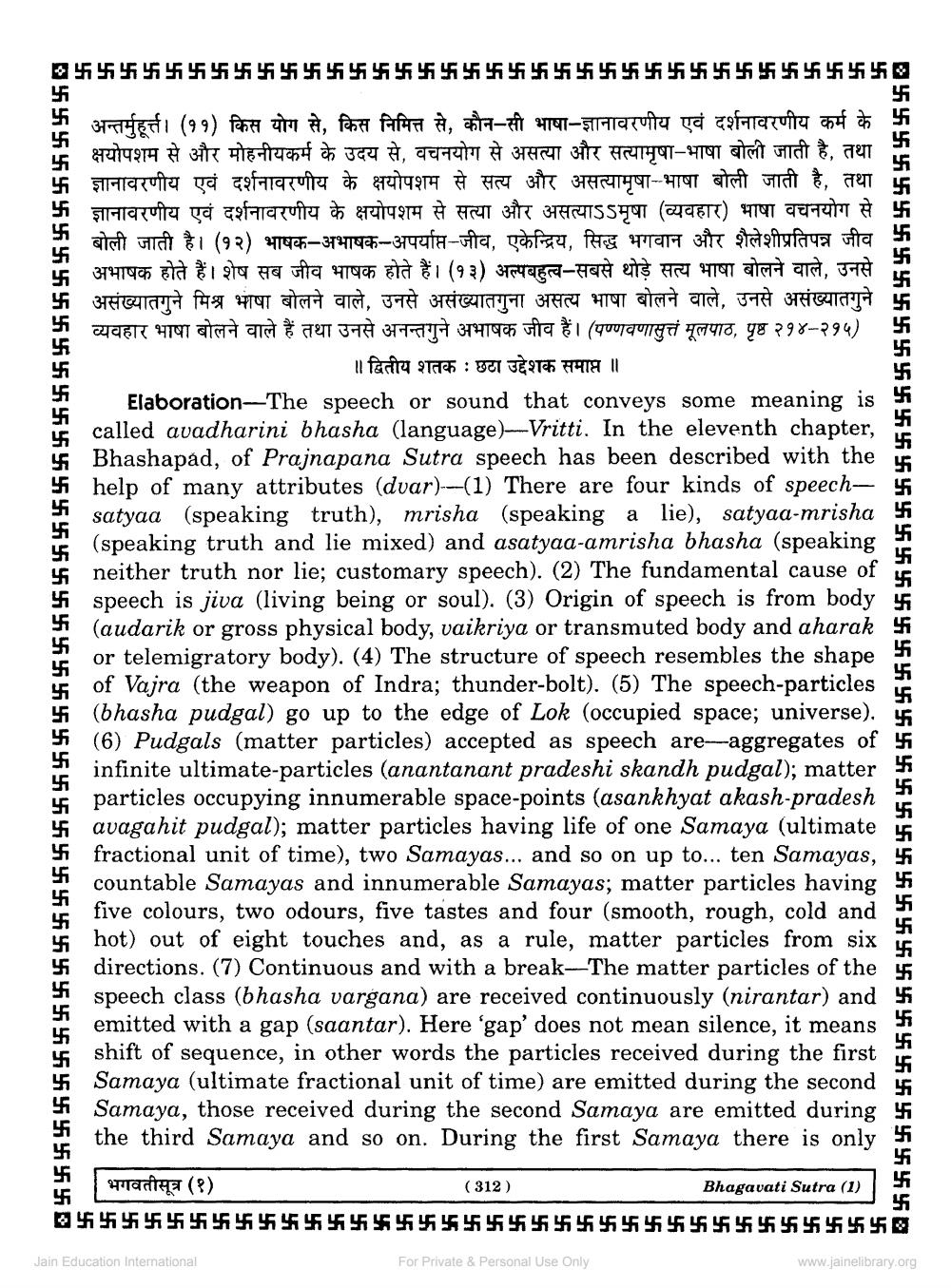________________
455555)))))))))))))55555555555558
ज)))))55555555555555555555555555555555555
+ अन्तर्मुहूर्त। (११) किस योग से, किस निमित्त से, कौन-सी भाषा-ज्ञानावरणीय एवं दर्शनावरणीय कर्म के
क्षयोपशम से और मोहनीयकर्म के उदय से, वचनयोग से असत्या और सत्यामृषा-भाषा बोली जाती है, तथा म ज्ञानावरणीय एवं दर्शनावरणीय के क्षयोपशम से सत्य और असत्यामृषा-भाषा बोली जाती है, तथा ऊ ज्ञानावरणीय एवं दर्शनावरणीय के क्षयोपशम से सत्या और असत्याऽऽमृषा (व्यवहार) भाषा वचनयोग से
बोली जाती है। (१२) भाषक-अभाषक-अपर्याप्त-जीव, एकेन्द्रिय, सिद्ध भगवान और शैलेशीप्रतिपन्न जीव
अभाषक होते हैं। शेष सब जीव भाषक होते हैं। (१३) अल्पबहुत्व-सबसे थोड़े सत्य भाषा बोलने वाले, उनसे ॐ असंख्यातगुने मिश्र भाषा बोलने वाले, उनसे असंख्यातगुना असत्य भाषा बोलने वाले, उनसे असंख्यातगुने व्यवहार भाषा बोलने वाले हैं तथा उनसे अनन्तगुने अभाषक जीव हैं। (पण्णवणासुत्तं मूलपाठ, पृष्ठ २१४-२१५)
॥ द्वितीय शतक : छठा उद्देशक समाप्त ॥ Elaboration-The speech or sound that conveys some meaning is called avadharini bhasha (language Vritti. In the eleventh chapter,
Bhashapad, of Prajnapana Sutra speech has been described with the 卐 help of many attributes (dvar)-(1) There are four kinds of speech
satyaa (speaking truth), mrisha (speaking a lie), satyaa-mrisha (speaking truth and lie mixed) and asatyaa-amrisha bhasha (speaking neither truth nor lie; customary speech). (2) The fundamental cause of speech is jiva (living being or soul). (3) Origin of speech is from body # (audarik or gross physical body, vaikriya or transmuted body and aharak
or telemigratory body). (4) The structure of speech resembles the shape 4 of Vajra (the weapon of Indra; thunder-bolt). (5) The speech-particles
(bhasha pudgal) go up to the edge of Lok (occupied space; universe). i (6) Pudgals (matter particles) accepted as speech are-aggregates of
infinite ultimate-particles (anantanant pradeshi skandh pudgal); matter particles occupying innumerable space-points (asankhyat akash-pradesh avagahit pudgal); matter particles having life of one Samaya (ultimate 15 fractional unit of time), two Samayas... and so on up to... ten Samayas, countable Samayas and innumerable Samayas; matter particles having five colours, two odours, five tastes and four (smooth, rough, cold and hot) out of eight touches and, as a rule, matter particles from six directions. (7) Continuous and with a break-The matter particles of the
speech class (bhasha vargana) are received continuously (nirantar) and ** emitted with a gap (saantar). Here 'gap' does not mean silence, it mea
shift of sequence, in other words the particles received during the first Samaya (ultimate fractional unit of time) are emitted during the second Samaya, those received during the second Samaya are emitted during the third Samaya and so on. During the first Samaya there is only
3555555555555555555555555555555558
| भगवतीसूत्र (१)
(312)
Bhagavati Sutra (1) 555555555555555555555555555555 Jain Education International For Private & Personal Use Only
www.jainelibrary.org




